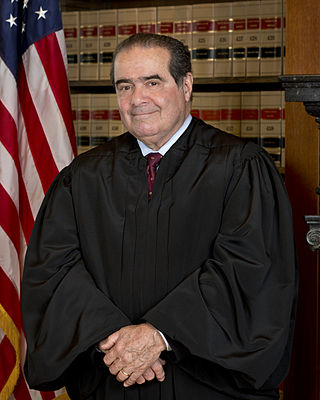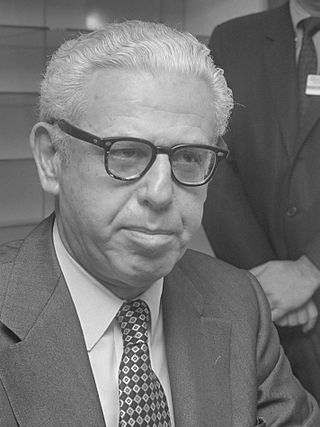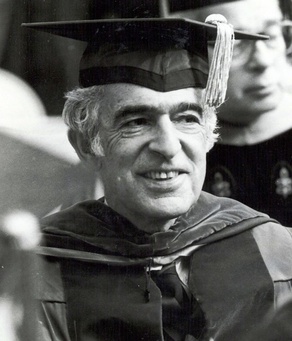
Hugo Lafayette Black was an American lawyer, politician, and jurist who served as a U.S. Senator from Alabama from 1927 to 1937 and as an associate justice of the U.S. Supreme Court from 1937 to 1971. A member of the Democratic Party and a devoted New Dealer, Black endorsed Franklin D. Roosevelt in both the 1932 and 1936 presidential elections.

Antonin Gregory Scalia was an American jurist who served as an associate justice of the Supreme Court of the United States from 1986 until his death in 2016. He was described as the intellectual anchor for the originalist and textualist position in the U.S. Supreme Court's conservative wing. For catalyzing an originalist and textualist movement in American law, he has been described as one of the most influential jurists of the twentieth century, and one of the most important justices in the history of the Supreme Court. Scalia was posthumously awarded the Presidential Medal of Freedom in 2018, and the Antonin Scalia Law School at George Mason University was named in his honor.

Abraham Fortas was an American lawyer and jurist who served as an associate justice of the Supreme Court of the United States from 1965 to 1969. Born and raised in Memphis, Tennessee, Fortas graduated from Rhodes College and Yale Law School. He later became a law professor at Yale Law School and then an advisor for the U.S. Securities and Exchange Commission. Fortas worked at the Department of the Interior under President Franklin D. Roosevelt, and was appointed by President Harry S. Truman to delegations that helped set up the United Nations in 1945.

Originalism is a method of constitutional and statutory interpretation. Originalists assert that legal text should be interpreted based on the original understanding at the time of adoption. Originalists object to the idea of the significant legal evolution being driven by judges in a common law framework and instead favor modifications of laws through the Legislature or through Constitutional amendment.

The Supreme Court of the United States is the highest-ranking judicial body in the United States. Established by Article III of the Constitution, the detailed structure of the court was laid down by the 1st United States Congress in 1789. Congress specified the Court's original and appellate jurisdiction, created 13 judicial districts, and fixed the initial size of the Supreme Court. The number of justices on the Supreme Court changed six times before settling at the present total of nine in 1869. As of June 2022, a total of 116 justices have served on the Supreme Court since 1789. Justices have life tenure, and so they serve until they die in office, resign or retire, or are impeached and removed from office.

Felix Frankfurter was an Austrian-born American jurist who served as an Associate Justice of the Supreme Court of the United States from 1939 until 1962, during which period he was a noted advocate of judicial restraint in its judgements.

William Orville Douglas Sr. was an American jurist who served as an associate justice of the Supreme Court of the United States from 1939 to 1975. Douglas was known for his strong progressive and civil libertarian views and is often cited as the U.S. Supreme Court's most liberal justice ever. Nominated by President Franklin D. Roosevelt in 1939, Douglas was confirmed at the age of 40, becoming one of the youngest justices appointed to the court. In 1975, Time called Douglas "the most doctrinaire and committed civil libertarian ever to sit on the court." He is the longest-serving justice in history, having served for 36 years and 211 days.

Arthur Joseph Goldberg was an American statesman and jurist who served as the 9th U.S. Secretary of Labor, an Associate Justice of the Supreme Court of the United States, and the 6th United States Ambassador to the United Nations.

The Warren Court was the period in the history of the Supreme Court of the United States from 1953 to 1969 during which Earl Warren served as the chief justice. The Warren Court is often considered the most liberal court in U.S. history.

The demographics of the Supreme Court of the United States encompass the gender, ethnicity, and religious, geographic, and economic backgrounds of the 116 people who have been appointed and confirmed as justices to the Supreme Court. Some of these characteristics have been raised as an issue since the court was established in 1789. For its first 180 years, justices were almost always white male Protestants of Anglo or Northwestern European descent.

The lists of law clerks of the Supreme Court of the United States cover the law clerks who have assisted the justices of the Supreme Court of the United States in various capacities since the first one was hired by Justice Horace Gray in 1882. The list is divided into separate lists for each position in the Supreme Court.

James Clark McReynolds was an American lawyer and judge from Tennessee who served as United States Attorney General under President Woodrow Wilson and as an associate justice of the Supreme Court of the United States. He served on the Court from 1914 to his retirement in 1941. McReynolds is best known today for his sustained opposition to the domestic programs of President Franklin D. Roosevelt and his personality, which was widely viewed negatively and included documented elements of overt antisemitism and racism. Born in Elkton, Kentucky, McReynolds practiced law in Tennessee after graduating from the University of Virginia School of Law. He served as the U.S. Assistant Attorney General during President Theodore Roosevelt's administration and became well known for his skill in antitrust cases. After Wilson took office in 1913, he appointed McReynolds as his administration's first attorney general. Wilson nominated McReynolds to the Supreme Court in 1914 to fill the vacancy caused by Associate Justice Horace Harmon Lurton's death.
During his twelve years in office, President Franklin D. Roosevelt appointed eight new members of the Supreme Court of the United States: Associate Justices Hugo Black, Stanley F. Reed, Felix Frankfurter, William O. Douglas, Frank Murphy, James F. Byrnes, Robert H. Jackson, and Wiley Blount Rutledge. Additionally, he elevated sitting Justice Harlan F. Stone to chief justice. Roosevelt's nine nominations filled eight seats on the Supreme Court because Byrnes resigned while Roosevelt was still in office. Roosevelt nominated Rutledge to the seat vacated by Byrnes.

Henry Julian Abraham was a German-born American scholar on the judiciary and constitutional law. He was James Hart Professor of Government Emeritus at the University of Virginia. He was the author of 13 books, most in multiple editions, and more than 100 articles on the U.S. Supreme Court, judicial appointments, judicial process, and civil rights and liberties.

Louis Dembitz Brandeis was an American lawyer who served as an associate justice on the Supreme Court of the United States from 1916 to 1939.

Thomas Rex Lee is a former American jurist who was a justice of the Utah Supreme Court from 2010 to 2022. Lee is also a lecturer on law at Harvard Law School and an adjunct professor/distinguished lecturer at Brigham Young University's (BYU) J. Reuben Clark Law School (JRCL) following his appointment to the bench.

The Stone Court refers to the Supreme Court of the United States from 1941 to 1946, when Harlan F. Stone served as Chief Justice of the United States. Stone succeeded the retiring Charles Evans Hughes in 1941, and served as Chief Justice until his death, at which point Fred Vinson was nominated and confirmed as Stone's replacement. He was the fourth chief justice to have previously served as an associate justice and the second to have done so without a break in tenure. Presiding over the country during World War II, the Stone Court delivered several important war-time rulings, such as in Ex parte Quirin, where it upheld the President's power to try Nazi saboteurs captured on American soil by military tribunals. It also supported the federal government's policy of relocating Japanese Americans into internment camps.

The Vinson Court refers to the Supreme Court of the United States from 1946 to 1953, when Fred M. Vinson served as Chief Justice of the United States. Vinson succeeded Harlan F. Stone as Chief Justice after the latter's death, and Vinson served as Chief Justice until his death, at which point Earl Warren was nominated and confirmed to succeed Vinson.
Woodrow Wilson appointed three Associate Justices to the Supreme Court of the United States, James Clark McReynolds, Louis Brandeis, and John Hessin Clarke.















